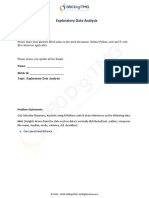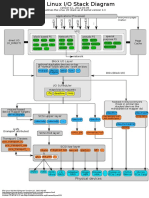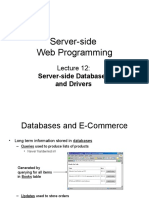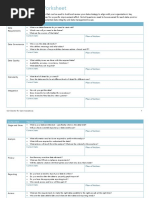Assignment 03
Uploaded by
Ritika AwasthiAssignment 03
Uploaded by
Ritika AwasthiAssignment:-03
Introduction to sql and sql commands
Instructions:
Please share your answers filled in line in the Word document. Submit code
separately wherever applicable.
Please ensure you update all the details:
Name: _Ritika Awasthi____________ Batch ID: ___________
Topic: Introduction to sql and sql commands
1) What is SQL, and what are some common uses for it in database management?
2) What is a foreign key in SQL, and how is it used to establish relationships
between tables?
DATABASE CREATE:-
1. Create a database ‘classroom’
2. Create a table named ‘science_class’ with the following properties
3 columns(enrollment_no int, name varchar, science_marks int)
INSERTING & IMPORTING:-
1. Insert the following data into science_class using insert into command
1 popeye 33
2 olive 54
3 brutus 98
2. Import data from CSV file ‘student.csv’ attached in resources to
science_class to insert data of next 8 students
SELECT & WHERE:-
1. Retrieve all data from the table ‘Science_Class’
2. Retrieve the name of students who have scored more than 60 marks
© 360DigiTMG. All Rights Reserved.
Assignment:-03
Introduction to sql and sql commands
3. Retrieve all data of students who have scored more than 35 but less than
60 marks
4. Retrieve all other students i.e. who have scored less than or equal to 35
or more than or equal to 60.
UPDATING TABLES:-
1. Update the marks of popeye to 45
2. Delete the row containing details of the student named ‘robb’
3. Rename column ‘name’ to ‘student_name’
SQL (Structured Query Language) is a programming language used for managing and
manipulating relational databases. It is the standard language for relational database
management systems (RDBMS) such as MySQL, PostgreSQL, SQL Server, Oracle, and SQLite.
SQL provides a standardized way to interact with databases, allowing users to perform
various operations like querying, inserting, updating, deleting, and managing database
structures.Here are some common uses of SQL in database management:
1. Querying Data: SQL allows users to retrieve data from databases using the SELECT
statement. Users can specify criteria to filter data, sort results, and perform calculations on
retrieved data.
2. Modifying Data: SQL provides commands such as INSERT, UPDATE, and DELETE to add,
modify, and remove data from database tables.
3. Creating and Modifying Database Structures: SQL allows users to define the structure of
databases and database objects such as tables, indexes, views, and stored procedures using
commands like CREATE, ALTER, and DROP.
4. Data Integrity and Constraints: SQL supports the definition of constraints such as primary
keys, foreign keys, unique constraints, and check constraints to ensure data integrity and
enforce business rules.
5. Data Manipulation and Transformation: SQL provides functions and operators for
manipulating and transforming data, such as arithmetic operations, string functions, date
and time functions, and aggregate functions like SUM, AVG, COUNT, MIN, and MAX.
6. Data Security: SQL allows users to manage database security by defining user permissions
and roles to control access to data and database objects.
7. Data Backup and Recovery
© 360DigiTMG. All Rights Reserved.
Assignment:-03
Introduction to sql and sql commands
In SQL, a foreign key is a column or a set of columns in a table that establishes a relationship
with another table's primary key or a unique key constraint. It ensures referential integrity
between the data in the two related tables. The foreign key constraint enforces that the
values in the foreign key column(s) of one table must match the values in the primary key
column(s) of another table or a unique key constraint.
CREATE TABLE Orders (
OrderID INT PRIMARY KEY,
CustomerID INT,
OrderDate DATE,
FOREIGN KEY (CustomerID) REFERENCES Customers(CustomerID)
);
In the above example, the CustomerID column in the Orders table is a foreign key that
references the CustomerID column in the Customers table. This establishes a relationship
between the Orders table and the Customers table, indicating that each order must be
associated with an existing customer.
1. Create database classroom;
Use database;
2.CREATE TABLE science_class (
enrollment_no INT PRIMARY KEY,
name VARCHAR(255),
science_marks INT
);
1.INSERT INTO science_class (enrollment_no, name, science_marks) VALUES
(1, 'popeye', 33),
(2, 'olive', 54),
(3, 'brutus', 98);
© 360DigiTMG. All Rights Reserved.
Assignment:-03
Introduction to sql and sql commands
2.LOAD DATA INFILE 'path_to_your_file/student.csv'
INTO TABLE science_class
FIELDS TERMINATED BY ','
ENCLOSED BY '"'
LINES TERMINATED BY '\n'
IGNORE 1 LINES;
1. SELECT * FROM science_class;
2.SELECT name FROM science_class WHERE science_marks > 60;
3.SELECT * FROM science_class WHERE science_marks > 35 AND science_marks < 60;
4.SELECT * FROM science_class WHERE science_marks <= 35 OR science_marks >= 60;
1.UPDATE science_class SET science_marks = 45 WHERE name = 'popeye';
2.DELETE FROM science_class WHERE name = 'robb';
3.ALTER TABLE science_class CHANGE COLUMN name student_name VARCHAR(255);
© 360DigiTMG. All Rights Reserved.
You might also like
- Module-Preliminaries For Data Analysis - Data Science100% (1)Module-Preliminaries For Data Analysis - Data Science5 pages
- Windows Registry-The Configuration Manager 5-21No ratings yetWindows Registry-The Configuration Manager 5-2189 pages
- Business Uderstanding Solved1 - Module 1No ratings yetBusiness Uderstanding Solved1 - Module 111 pages
- Module 7 Python For Data Analytics AssignmentNo ratings yetModule 7 Python For Data Analytics Assignment5 pages
- Day02-Data Understanding Answer Asit 25082022No ratings yetDay02-Data Understanding Answer Asit 250820224 pages
- CRISP DM Business Understanding - Data ScienceNo ratings yetCRISP DM Business Understanding - Data Science15 pages
- Duplication - Typecasting-Problem Statement100% (1)Duplication - Typecasting-Problem Statement3 pages
- CRISP DM Business Understanding CompletedNo ratings yetCRISP DM Business Understanding Completed18 pages
- Name: Siti Mursyida Abdul Karim (Data Science Program) Topic: Assignment - EDA100% (1)Name: Siti Mursyida Abdul Karim (Data Science Program) Topic: Assignment - EDA13 pages
- CRISP - ML (Q) - Business UnderstandingNo ratings yetCRISP - ML (Q) - Business Understanding13 pages
- Support Vector Machines Problem StatementNo ratings yetSupport Vector Machines Problem Statement27 pages
- DataPreparation - Outlier - Treatment ASSIGNMENT 1100% (1)DataPreparation - Outlier - Treatment ASSIGNMENT 17 pages
- Name:Silpa Batch Id: Analysis: WDEO 171220 Topic: Principal Component100% (1)Name:Silpa Batch Id: Analysis: WDEO 171220 Topic: Principal Component7 pages
- Topic: Dimension Reduction With PCA: InstructionsNo ratings yetTopic: Dimension Reduction With PCA: Instructions8 pages
- CRISP - ML (Q) - Business Understanding AssignmentNo ratings yetCRISP - ML (Q) - Business Understanding Assignment11 pages
- 1 - Write A Python Program To Check That A String Contains Only A Certain Set of Characters (In This Case A-Z, A-Z and 0-9)No ratings yet1 - Write A Python Program To Check That A String Contains Only A Certain Set of Characters (In This Case A-Z, A-Z and 0-9)4 pages
- 6051baa1-7120-4ee5-861d-415c4e8da7ed_SQLNo ratings yet6051baa1-7120-4ee5-861d-415c4e8da7ed_SQL4 pages
- Easy Crambible Lab: Oracle Database 10G:Administration INo ratings yetEasy Crambible Lab: Oracle Database 10G:Administration I6 pages
- Transactions and Concurrency Management: Unit-IvNo ratings yetTransactions and Concurrency Management: Unit-Iv21 pages
- Veeam Backup & Replication 9.5 Update 4b Release NotesNo ratings yetVeeam Backup & Replication 9.5 Update 4b Release Notes29 pages
- Oracle Database Migration: Ata Pump Ource TepsNo ratings yetOracle Database Migration: Ata Pump Ource Teps8 pages
- Stream Is Used For Writing Into The File (Write Operation) .: I/O Class DescriptionNo ratings yetStream Is Used For Writing Into The File (Write Operation) .: I/O Class Description4 pages
- SAP Landscape Transformation Replication Server (SLT) : Non ABAP-based SourcesNo ratings yetSAP Landscape Transformation Replication Server (SLT) : Non ABAP-based Sources5 pages
- PowerBIArchitectureEndToEnd MelissaCoates-1No ratings yetPowerBIArchitectureEndToEnd MelissaCoates-172 pages
- A Seminar Presentation: Honeypots and SQL InjectionNo ratings yetA Seminar Presentation: Honeypots and SQL Injection39 pages
- Data Strategy Worksheet: Component Typical QuestionsNo ratings yetData Strategy Worksheet: Component Typical Questions2 pages
- Unit 4 Database Design and Query ProcessingNo ratings yetUnit 4 Database Design and Query Processing60 pages
- Module-Preliminaries For Data Analysis - Data ScienceModule-Preliminaries For Data Analysis - Data Science
- Name: Siti Mursyida Abdul Karim (Data Science Program) Topic: Assignment - EDAName: Siti Mursyida Abdul Karim (Data Science Program) Topic: Assignment - EDA
- DataPreparation - Outlier - Treatment ASSIGNMENT 1DataPreparation - Outlier - Treatment ASSIGNMENT 1
- Name:Silpa Batch Id: Analysis: WDEO 171220 Topic: Principal ComponentName:Silpa Batch Id: Analysis: WDEO 171220 Topic: Principal Component
- CRISP - ML (Q) - Business Understanding AssignmentCRISP - ML (Q) - Business Understanding Assignment
- 1 - Write A Python Program To Check That A String Contains Only A Certain Set of Characters (In This Case A-Z, A-Z and 0-9)1 - Write A Python Program To Check That A String Contains Only A Certain Set of Characters (In This Case A-Z, A-Z and 0-9)
- Easy Crambible Lab: Oracle Database 10G:Administration IEasy Crambible Lab: Oracle Database 10G:Administration I
- Veeam Backup & Replication 9.5 Update 4b Release NotesVeeam Backup & Replication 9.5 Update 4b Release Notes
- Stream Is Used For Writing Into The File (Write Operation) .: I/O Class DescriptionStream Is Used For Writing Into The File (Write Operation) .: I/O Class Description
- SAP Landscape Transformation Replication Server (SLT) : Non ABAP-based SourcesSAP Landscape Transformation Replication Server (SLT) : Non ABAP-based Sources
- A Seminar Presentation: Honeypots and SQL InjectionA Seminar Presentation: Honeypots and SQL Injection
- Data Strategy Worksheet: Component Typical QuestionsData Strategy Worksheet: Component Typical Questions

























































































